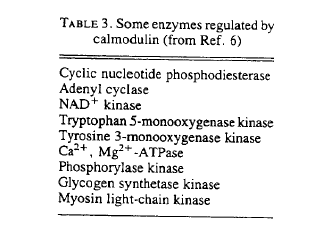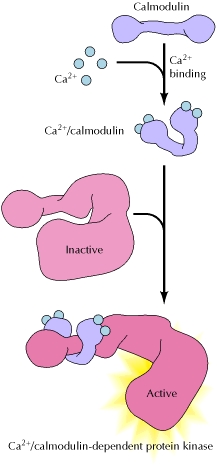Basic Information Concerning the Function of Calmodulin
Calmodulin transduces calcium ion signals by activating other proteins. Calmodulin need 4 calcium ions to bind in order to be activated and change conformation (Dutta et al., 2003). It is the conformation change of calmodulin that triggers the binding and allosertic modification of other proteins. Therefore CaM is an intracellular calcium-binding protein that acts as a intermediary in calcium signal transduction pathways. The basic function of calmodulin can be visualized again in the following diagram.
(Cooper, 2000)
Calmodulin is a relatively versatile protein because it has the ability to bind to and activate more than 20 different enzymes and structural proteins (Finn et al., 1995). The ability of calmodulin to regulate a wide-range of proteins makes it an essential and important signal transducing protein, which explains why it is involved in many different processes such as smooth muscle contraction and nerve signaling and why it is expressed in many different types of eukaryotic cell types. The table below (Table 3) illustrates the versatility of calmodulin by listing only some of the enzymes that calmodulin can bind to and regulate:

(Stevens, 1982)
As previously stated, calmodulin can bind 4 calcium ions, but the relative affinity of calcium ions to the calmodulin protein has been debated. Researchers generally agree that at higher levels of calcium within the cell the binding sites for calcium will be highly occupied. For instance, in a resting cell, the intracellular concentration of calcium ions is between 50-100 nM, but levels may rise to 1-10 uM with external stimuli. The affinity of calmodulin ". . . is such that the calcium ion binding sites will be largely unoccupied at the resting cell calcium ion concentrations, but highly occupied at the higher levels after stimulus" (Finn et al., 1995).
Please direct questions or comments to karicheson@davidson.edu
